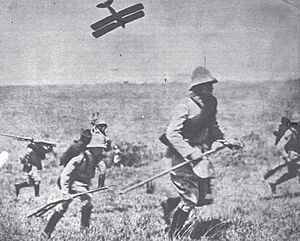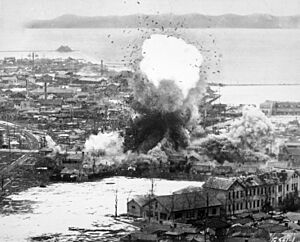Airstrike facts for kids
An airstrike is when aircraft attack a target on the ground or at sea. It's like a military operation from the sky. Planes, helicopters, or even drones can carry out airstrikes.
Airstrikes use different kinds of weapons. These can be cannons and machine guns, rockets, or air-to-surface missiles. They also use various types of aerial bombs. Sometimes, even advanced weapons like laser weapons are used.
In battles, airstrikes often work closely with ground troops. Special observers on the ground help guide the aircraft. This makes sure the attacks hit the right targets. It also helps avoid hitting friendly forces.
Contents
History of Airstrikes
Early Air Attacks
The first big air attack happened during World War I in 1915. German Zeppelin airships bombed London at night. Many people were asleep, so a loud warning system was needed. This led to the invention of the air raid siren. These sirens would warn people to take cover.
World War II and New Weapons
The term "airstrike" became common during World War II. This war also saw the first precision-guided munitions. These are bombs or missiles that can be guided to hit a very specific target. This made airstrikes much more accurate. Before this, planes often had to drop many bombs to hit one target.
With guided weapons, planes could hit targets with much less damage to other areas. This meant fewer bombs were needed to destroy a target. It also helped reduce accidental damage to places like churches or homes.
Airstrikes After World War II
After World War II, aircraft continued to improve. In the 1950s, British planes like Avro Lincoln bombers and de Havilland Vampire jets were used in the Malayan Emergency.
During the Vietnam War, new jet aircraft became common. Planes like the North American F-100 Super Sabre and McDonnell Douglas F-4 Phantom II were much faster. They could carry more weapons than older planes. Later, aircraft like the Cessna A-37 Dragonfly were designed for closer support.
Today, many fighter aircraft can also perform airstrikes. They are called "strike aircraft." This is because modern jets can do many jobs. Airstrikes are still used in many conflicts around the world. These include the Gulf War, the War on Terror, and the 2022 Russian invasion of Ukraine.
Impact on Civilians

Sometimes, airstrikes can accidentally harm people who are not involved in fighting. These are called non-combatants or civilians. To prevent this, international laws guide how airstrikes should be carried out.
These laws say that attacks must only target military objectives. They also say that any harm to civilians should be as small as possible. Modern military aircraft often use precision-guided weapons. These weapons are designed to hit targets very accurately. This helps to reduce harm to civilians.
See also
- Aerial bombing of cities
- Aerial warfare
- Atomic bombings of Hiroshima and Nagasaki
- Strategic bombing
- Time on target





